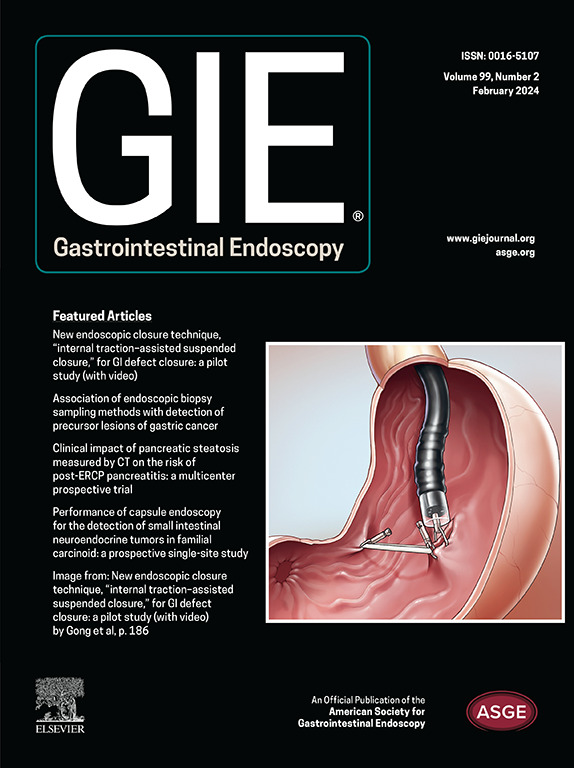Use patterns, technical challenges, and patient selection associated with single-use duodenoscopes and duodenoscopes with single-use endcaps in the United States and Canada
IF 6.7
1区 医学
Q1 GASTROENTEROLOGY & HEPATOLOGY
引用次数: 0
Abstract
Background and Aims
The extent of adoption, patient selection, and use patterns of single-use duodenoscopes and duodenoscopes with single-use endcaps have not yet been characterized, and large-scale assessments of endoscopist-reported function and challenges have not been reported.
Methods
An anonymous 6-minute electronic survey assessing use and experience with single-use duodenoscopes and duodenoscopes with novel design features was distributed to U.S. and Canadian endoscopy centers, and responses were analyzed using descriptive statistics.
Results
The survey was notable for a 70.2% response rate, with representation from academic (68.9%), community (18%), and veterans affairs (8.2%) centers. Most institutions used standard reprocessable duodenoscopes and duodenoscopes with single-use endcaps (34.4%) or a mix of standard reprocessable duodenoscopes, duodenoscopes with single-use endcaps, and single-use duodenoscopes (29.5%). No center used only single-use duodenoscopes. Some institutions (10.3%) planned to transition to duodenoscopes with a single-use endcap, 10.3% to a mix of single-use duodenoscopes and duodenoscopes with a single-use endcap, and 1.7% to single-use duodenoscopes alone. Challenges were reported with each type of novel duodenoscope, and selection patterns for use were characterized.
Conclusions
This first of its kind, large-scale survey of use patterns and functionality of newly introduced duodenoscopes is notable for the fairly widespread use of duodenoscopes with single-use endcaps and more limited use of single-use duodenoscopes. Both novel duodenoscope designs are associated with mechanical limitations that respondents indicate represent challenges to successful completion of ERCPs.
美国和加拿大一次性使用十二指肠镜和一次性使用带盖十二指肠镜的使用模式、技术挑战和患者选择。
背景和目的:一次性使用的十二指肠镜和带有一次性使用内盖的十二指肠镜的采用程度、患者选择和使用模式尚未定性,对内镜医师报告的功能和挑战的大规模评估也是如此:向美国和加拿大的内镜中心分发了一份 6 分钟的匿名电子调查表,评估一次性使用十二指肠镜和具有新颖设计特点的十二指肠镜的使用情况和经验,并使用描述性统计对回复进行分析:该调查的回复率为 70.2%,其中包括学术中心(68.9%)、社区中心(18%)和退伍军人事务中心(8.2%)。大多数机构使用标准可再处理十二指肠镜和带一次性使用端盖的十二指肠镜(34.4%),或混合使用标准可再处理十二指肠镜、带一次性使用端盖的十二指肠镜和一次性使用十二指肠镜(29.5%)。没有一家中心只使用一次性十二指肠镜(0%)。10.3%的中心计划过渡到使用带一次性内盖的十二指肠镜,10.3%的中心计划过渡到混合使用一次性十二指肠镜和带一次性内盖的十二指肠镜,1.7%的中心计划过渡到仅使用一次性十二指肠镜。报告了每种新型十二指肠镜面临的挑战,并描述了使用时的选择模式:这项首次对新引进的十二指肠镜的使用模式和功能进行的大规模调查显示,带有一次性使用内盖的十二指肠镜的使用相当广泛,而一次性使用十二指肠镜的使用则较为有限。这两种新型十二指肠镜的设计都存在机械限制,受访者表示这对成功完成ERCP手术构成了挑战。
本文章由计算机程序翻译,如有差异,请以英文原文为准。
求助全文
约1分钟内获得全文
求助全文
来源期刊

Gastrointestinal endoscopy
医学-胃肠肝病学
CiteScore
10.30
自引率
7.80%
发文量
1441
审稿时长
38 days
期刊介绍:
Gastrointestinal Endoscopy is a journal publishing original, peer-reviewed articles on endoscopic procedures for studying, diagnosing, and treating digestive diseases. It covers outcomes research, prospective studies, and controlled trials of new endoscopic instruments and treatment methods. The online features include full-text articles, video and audio clips, and MEDLINE links. The journal serves as an international forum for the latest developments in the specialty, offering challenging reports from authorities worldwide. It also publishes abstracts of significant articles from other clinical publications, accompanied by expert commentaries.
 求助内容:
求助内容: 应助结果提醒方式:
应助结果提醒方式:


